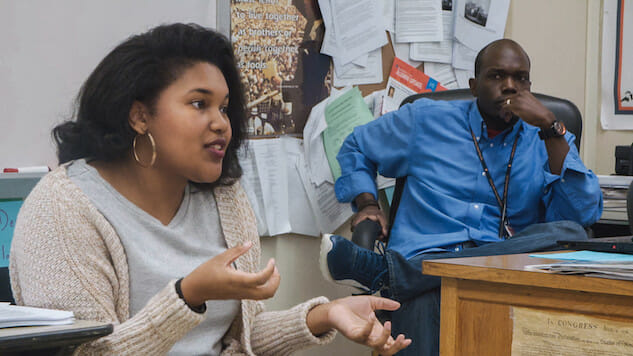Starz Documentary America to Me Is the Education ‘Woke’ Liberals Need
Photo: Starz
There’s a scene in the fourth episode of the new Starz docuseries America to Me that may make even the most assuredly “woke” white person pause for some self-reflection.
Aaron Podolner, a white, middle-aged physics teacher at the comfortably middle-class Oak Park and River Forest High School in Chicago, is determined that two of his African-American students—Jada Buford and Charles Donalson III—know exactly how much he gets them. So he asks them to read a personal essay he’s written about his experiences and how he wants to fuel change. Since we’ve already seen Podolner tell the cameras about his family’s history of fighting for civil rights and tell another teacher that he knows “just by being black, that they’ve had a different experience,” it’s both uncomfortable and unsurprising when his message to his students gets a little garbled, even if it’s delivered with the best of intentions.
And that’s kind of the point of America to Me: Racism, even when it isn’t the cross-burning kind, is so ingrained in our society that it’s almost unavoidable even by those who recognize it and want to help. The miniseries comes from Steve James, the director and producer known for nonfiction classics like Hoop Dreams, about two African-American high-school students in Chicago who are striving for the NBA, and The Interrupters, about those who try to mitigate violence in Chicago’s South Side.
For this project, James says that he didn’t want to go to the obvious places to see the problems of race and racism in this country; he wanted to look at where it plays out every day, in front of people who believe themselves to be progressives. So he returned to a setting he knew well: the high school where his own kids matriculated, and one that, like so many other places, has had its share of conflicts regarding race and society. In February 2015, the school made headlines thanks to a Black Lives Matter event that was limited to black students.
“I think liberals—white liberals in particular—have this sense that, ‘If I’m not racist in how I define what “racist” is, and especially if I live in a community that’s diverse and I send my kids to a diverse public high school, I’m doing my part,’” James tells Paste when we talk during this summer’s Television Critics Association press tour. “But, increasingly, what people are saying in the activist community is it’s not enough for white people to not be racist; they need to be anti-racist. And by that, I think what they mean is, they actually do something. They can’t just have liberal ideas and be sensitive or try to be sensitive.”
He adds that this is, “fundamentally, what you see in a community like Oak Park”: It’s considered a good school in a good neighborhood, and James suggests that, “because the school works really well for white families, it makes change harder. There’s a kind of complacency and a fear of real change because it works so well.”
James and his team—whom, he stresses, were not all middle-aged white guys like him—chronicled some of the Oak Park students, teachers and families for the 2015-2016 school year. In the course of the five episodes (of 10 total) that have been sent to the press, patterns and stories begin to emerge. There’s Terrence Moore, a soft-spoken junior with special needs whose single mother is pushing him (and his teachers) to go into higher-level classes, even though they may not be the best fit. He goes to the same school as his aunt, the bubbly cheerleader Tiara Oliphant, who is a sophomore and lives with Terrence. There are burgeoning activists like Buford, who talks in the series of feeling like an outsider when she previously attended a mostly white Catholic school, and who makes her own videos about her experiences with micro-aggressions and issues like the use of the N-word. There are kids from the school’s successful spoken word team, like Donalson (a junior; also raised by a single mom; also struggling academically, but for different reasons) and Chanti Relf, who is both biracial and figuring out issues of gender identity. There’s Kendale McCoy, who was raised by his great aunt and uncle and who is learning that there are simply not enough hours in the day to be both a marching-band leader with his white friends and succeed on the wrestling team with his black and Latino friends. And then there’s Grant Lee, a biracial freshman who is working up the nerve to ask out a girl.
-

-

-

-

-

-

-

-

-

-

-

-

-

-

-

-

-

-

-

-

-

-

-

-

-

-

-

-

-

-

-

-

-

-

-

-

-

-

-

-








































